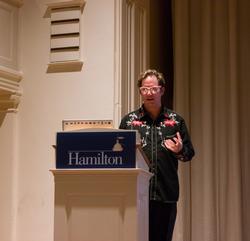Features
Alum John Freyer '95 sells all his possessions
By Lindsey Luker '15
September 27, 2012
In a world in which people are known for what they have, it takes a lot of nerve to give up our defining possessions. John Freyer ’95 took on this challenge and sold virtually everything he owned as part of a multimedia, interdisciplinary project.
Freyer visited the Hamilton campus on Sept. 24 to talk about his project and book, All My Life for Sale. The government major decided to put all of his possessions up for sale on eBay, all with a starting price of one dollar, in 2000. He has sold more than six hundred of his items, including his favorite shirt, his false teeth, his Jesus nightlight and his Hamilton College Class of 1995 New Faces catalogue.
Though his items are still being sold through eBay, Freyer created allmylifeforsale.com, a website where the public can read about the project and all of its developments. Freyer described his unique study of stuff as an “online project that explored our relationship to the objects around us, their role in the concept of identity, as well as the emerging commercial systems of the Internet.”
Freyer attached an anecdote outlining each item’s history and a description of his project when he shipped his things to their new homes. In return, he received photographs of the possessions in their new environments, as well as several invitations to visit the future owners as part of his project. Thus began Freyer’s road trip across the United States to revisit his old items.
In Nov. 2002, Freyer partnered with Bloomsbury USA and published All My Life for Sale, a full book detailing the purge and adding yet another dimension to the evolving phenomenon. The Emerson Museum of Art in Syracuse caught wind of Freyer’s project and, in 2005, put together an exhibit that consisted of photographs of the objects and their stories.
Freyer’s work tied in seamlessly with the Class of 2016 common reading material, Evocative Objects, a collection edited by Sherry Turkle. Both touch on the interconnectedness of objects – particularly our own possessions – and our identities. In his lecture, Freyer spoke specifically about suitcases.
“It’s a life – your life – in a suitcase. Everything’s right there.”
Freyer, now an assistant professor of photography at the University of Iowa, has tackled several new projects that share the themes of connectedness and materialism. He partnered with anthropologist Johan Lindquist to complete a Fulbright study in Sweden, where they analyzed extensively IKEA’s “Billy Bookshelf.”
Freyer drew a parallel between organizing our bookshelves and playing dress up.
“We show off our stuff in a way that will positively add to our image,” he said. “We take on this new persona, and our objects transform it.”
Freyer and Lindquist even went so far as to identify, with empirical support, the spot on the Billy Bookshelf where people tend to store their best possessions, the “Golden Objects” they want people to see.
“That spot right there, that’s where you put the books you want people to think you’ve read,” Freyer joked.
Throughout his lecture, Freyer highlighted the dependence we have on our stuff. He encouraged the audience to explore who we would be without our possessions speaking for us, to try to define ourselves beyond our cell phones, toothbrushes, ashtrays, and undeveloped rolls of film.
